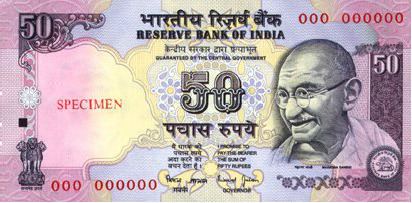Value ₹50 Height 73 mm | Width 147 mm | |
 | ||
Security features Secure thread, latent image, micro-lettering, intaglio print, fluorescent ink, watermark, and see through register. Years of printing November 1975 – present | ||
The Indian 50-rupee banknote (₹50) is a denomination of the Indian rupee. The present ₹50 banknote in circulation since 1996 is a part of the Mahatma Gandhi Series of banknotes.
Contents
The ₹50 banknote denomination was first introduced by the Reserve Bank of India (RBI) in 1975 as a part of the Lion Capital Series, which had the Ashoka pillar on the banknote. It was replaced by a watermark of Mahatma Gandhi in the Mahatma Gandhi Series, in 1996.
Mahatma Gandhi New Series
On 10 November 2016, the Reserve Bank of India announced, a new redesigned ₹50 banknote was to be available as a part of the Mahatma Gandhi New Series, in the coming months.
Design
The ₹50 banknote of the Mahatma Gandhi Series is 147 × 73 mm Pink-violet coloured, with the obverse side featuring a portrait of Mahatma Gandhi with a signature of the governor of Reserve Bank of India. It has the Braille feature to assist the visually challenged in identifying the currency. The reverse side features a motif of the Indian Parliament building.
As of 2012, the new ₹ sign has been incorporated into banknote of ₹50. In January 2014 RBI announced that it would be withdrawing from circulation all banknotes printed prior to 2005 by 31 March 2014. The deadline was later extended to 1 January 2015, then to 30 June 2016.
Security features
The security features of the ₹50 banknote includes:
Languages
Like the other Indian rupee banknotes, the ₹50 banknote has its amount written in 17 languages. On the obverse, the denomination is written in English and Hindi. On the reverse is a language panel which displays the denomination of the note in 15 of the 22 official languages of India. The languages are displayed in alphabetical order. Languages included on the panel are Assamese, Bengali, Gujarati, Kannada, Kashmiri, Konkani, Malayalam, Marathi, Nepali, Odia, Punjabi, Sanskrit, Tamil, Telugu and Urdu.
